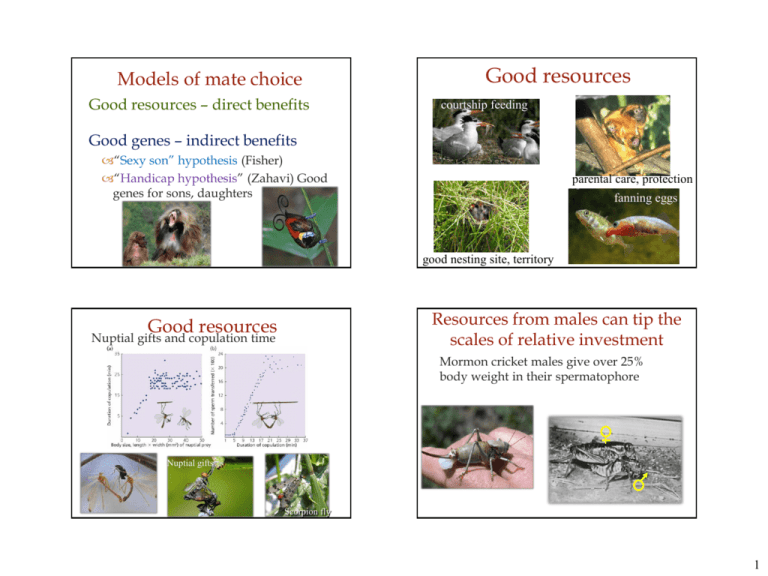Good resources
advertisement

Models of mate choice Good resources – direct benefits Good resources courtship feeding Good genes – indirect benefits “Sexy son” hypothesis (Fisher) “Handicap hypothesis” (Zahavi) Good genes for sons, daughters parental care, protection fanning eggs good nesting site, territory Resources from males can tip the scales of relative investment Good resources Nuptial gifts and copulation time Mormon cricket males give over 25% body weight in their spermatophore Nuptial gifts Scorpion fly 1 “Ultimate” nuptial gift Why does a spider female kill and eat her mate? Why does a praying mantis eat her mate’s head? Survival is just one strategy to transmit genes. When she eats him, she makes more eggs bearing his genes. His future reproductive chances are low “Sexy son” hypothesis Stalk-eyed flies (also stickleback ex. in text) 2 genetic strains were developed: males with short vs. long eye stalks. Selection on males. “Sexy son” hypothesis Fisher 1930 – A strictly genetic theory Females with preexisting sensory bias Males w/ this trait are selected, females with the preference are selected Trait might provide nothing beyond mating success The parents Trait A Preference A Trait A Their offspring Preference A “Sexy son” hypothesis This hypothesis predicts a ‘runaway’ effect When does it stop? Females of either strain preferred males from their own strain. Stalk-eyed fly 2 Handicap hypothesis Display can be indicator of health (choice based on ‘honest signal’) (Zahavi 1975) Handicap hypothesis External features, behavior can indicate general health Comb and tail length changes with infection Guppy females choose males who closely inspect predators Handicap hypothesis Peacock chick growth and survival is linked to ‘eyespot’ size. Handicap hypothesis When females are allowed to choose, their offspring have higher fitness fruit flies, ducks, mice, others However, females care more for their young when mated with preferred male 3 Mammals: where is the flashiness? Females prefer: Larger harems (ex. seals, ungulates) Dominant, older males w high T (olfac) Good caregivers (in spp w male care) What about horns, antlers? Their size correlates w/ many variables Increased male investment changes sexual selection Monogamy and equal care Sex-role reversals occur when males invest more Equal investment both are choosy Crested auklet Reversed sex roles: water bugs Male back space is limiting resource Females court males Sea dragons, sea horses, pipefish 4 After mating: competition goes on If females mate w/ more than one male Sperm competition Mate guarding Cryptic female choice Cryptic female choice Strategic allocation / ejection of sperm Behavior of dominant vs. subordinate males Cloacal contractions Mate guarding: benefits and costs Benefits and costs depend on opportunities Benefits to females: multiple mates Extra-pair copulations in ‘monogamous’ species 10-40% of offspring of song birds are from ‘adulterous’ matings indirect benefits Ex: Brown antechinus – polygamous females produced a greater portion of surviving young than monogamous females 5 Sexual conflict Sexual conflict When interests of males and females do not coincide ...what’s so stinky? Drosophila male accessory gland protein hanging flies heh heh heh…. paternity uncertainty higher # carriers female EPC’s less care by male Who wins the sexual arms race? Chase-away sexual selection Drosphila selection lines – show manipulation of arms race Male develops trait that happens to exploit a sensory bias that females already have Penis/vagina shape in ducks with forced copulations Females get ‘taken in’ by males that may actually be sub-par – selection to ‘resist’ Also predicts ‘runaway’ effect on male traits Duck vagina (left) and penis (right) 6 Chase-away sexual selection Preexisting female biases may drive Chase-away SS Platys and swordtails Basic types of mating systems Mating systems Monogamy Polygamy (polygyny, polyandry) Promiscuity or polygynandry Describes both social and sexual relationships Patterns and constraints in parental care Parental care occurs in a minority of animals What is the tradeoff? Costs for females vs. males Physiology, ecology, mating opportunities Patterns and constraints in parental care Ectotherms vs. Endotherms Internal vs. External fertilization Mammals vs. Birds 7 Level of parental care in ectotherms vs endotherms Endotherms – young have high energy demands and require warming and feeding. Ectotherms Parental care is rare among ectotherms “r-selection” instead Most investment costs are from mating or eggs Examples of rare care - guarding Constraints on mammals vs. birds One or two parents? Demands of young - compare RS of uni- and biparental care. Opportunity to find a mate – if you desert, what are the chances to find mate, territory? Opportunity to desert Constraints on mammals vs. birds Birds - 90% of spp. are monogamous biparental care Mammals - 95% spp. are polygynous Constraints on care 8 Why do some ectotherms care? Energy and opportunity costs are still similar to noncaring spp., but RS benefits of care are much higher. As soon as one parent is caring, benefits for other to care are reduced. What gender should care? Ectotherm uniparental care Internal vs. External fertilization External fertilization Male guarding eggs Why is male care associated w/external fertilization? 1. Paternity certainty 2. Order of gamete release 3. ‘Association’ with eggs Internal fertilization Female octopus guarding eggs Polygyny and male care along reefs Resource defense polygyny in reef fish (external f), cuttlefish (internal f) males defend multiple nest sites, guard eggs, have multiple mates 9






